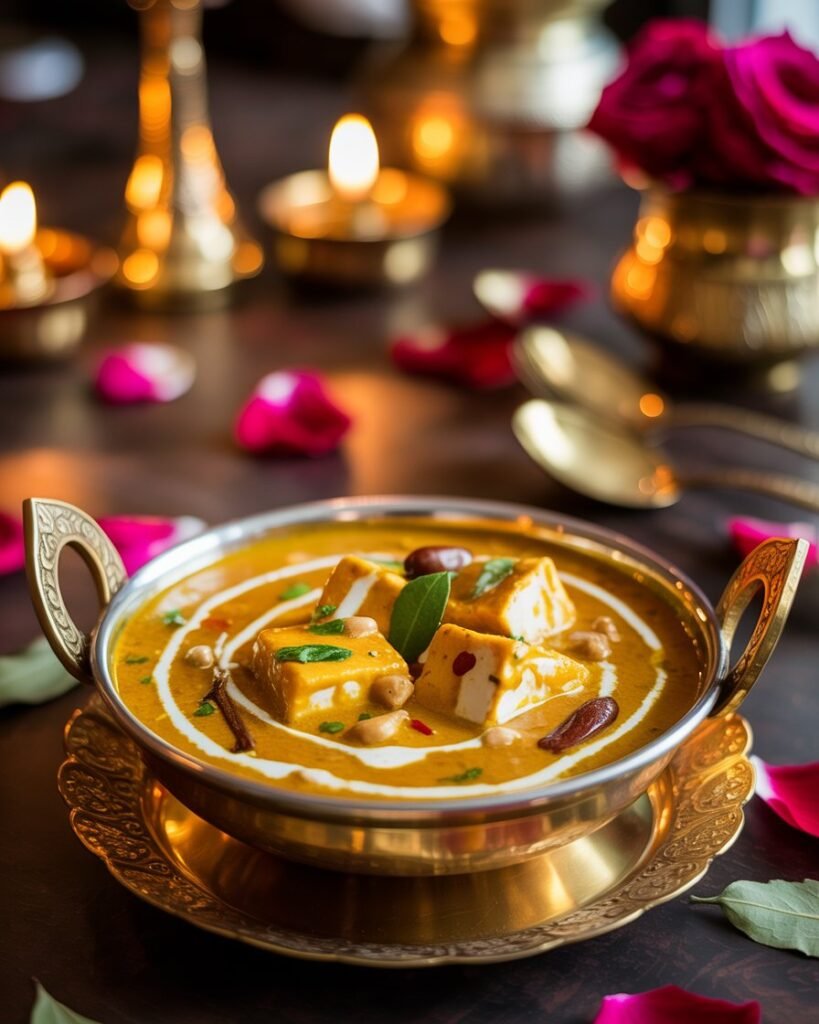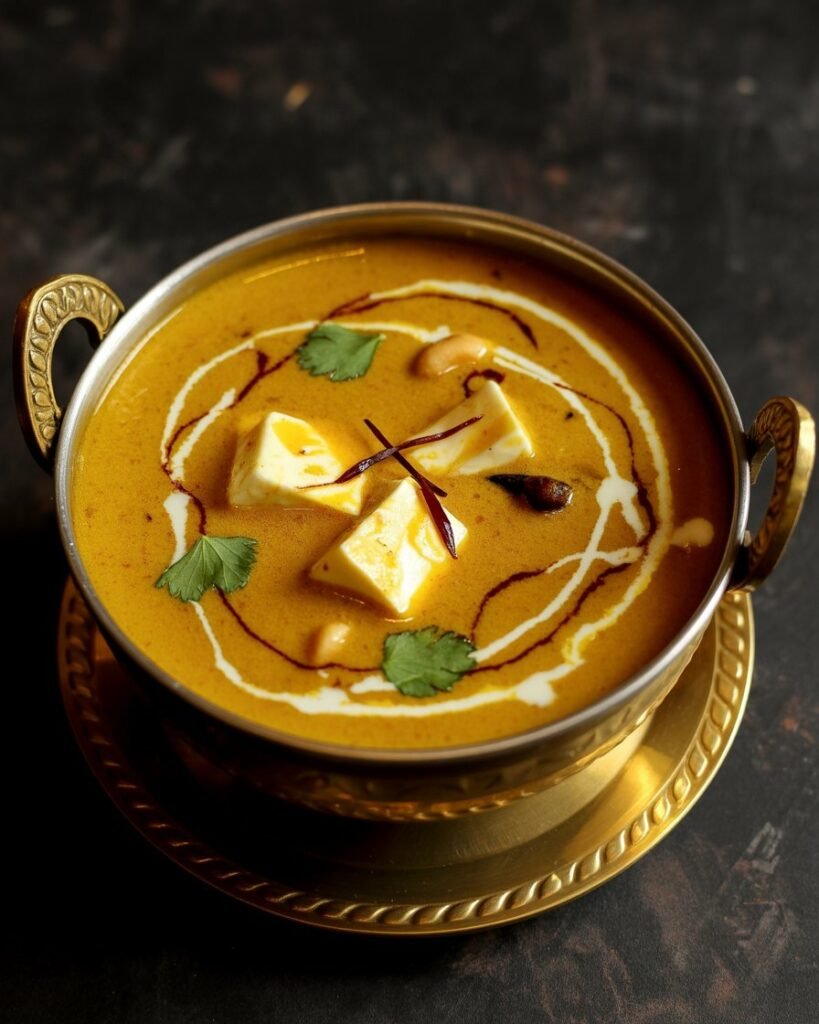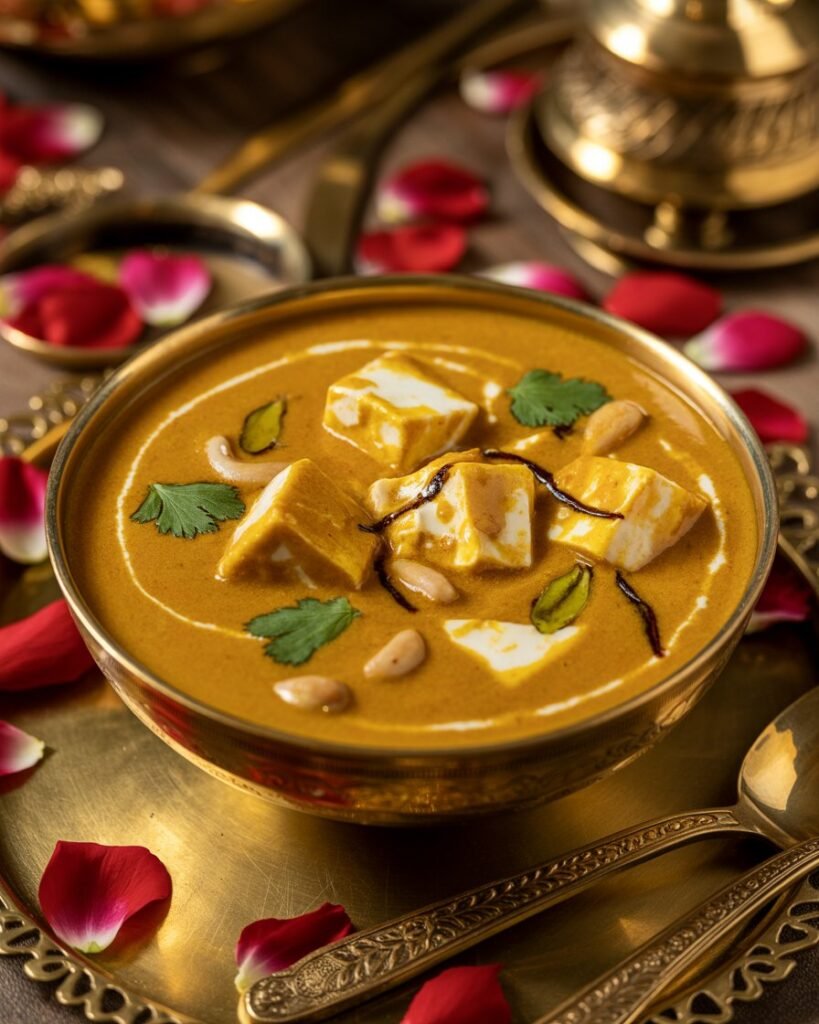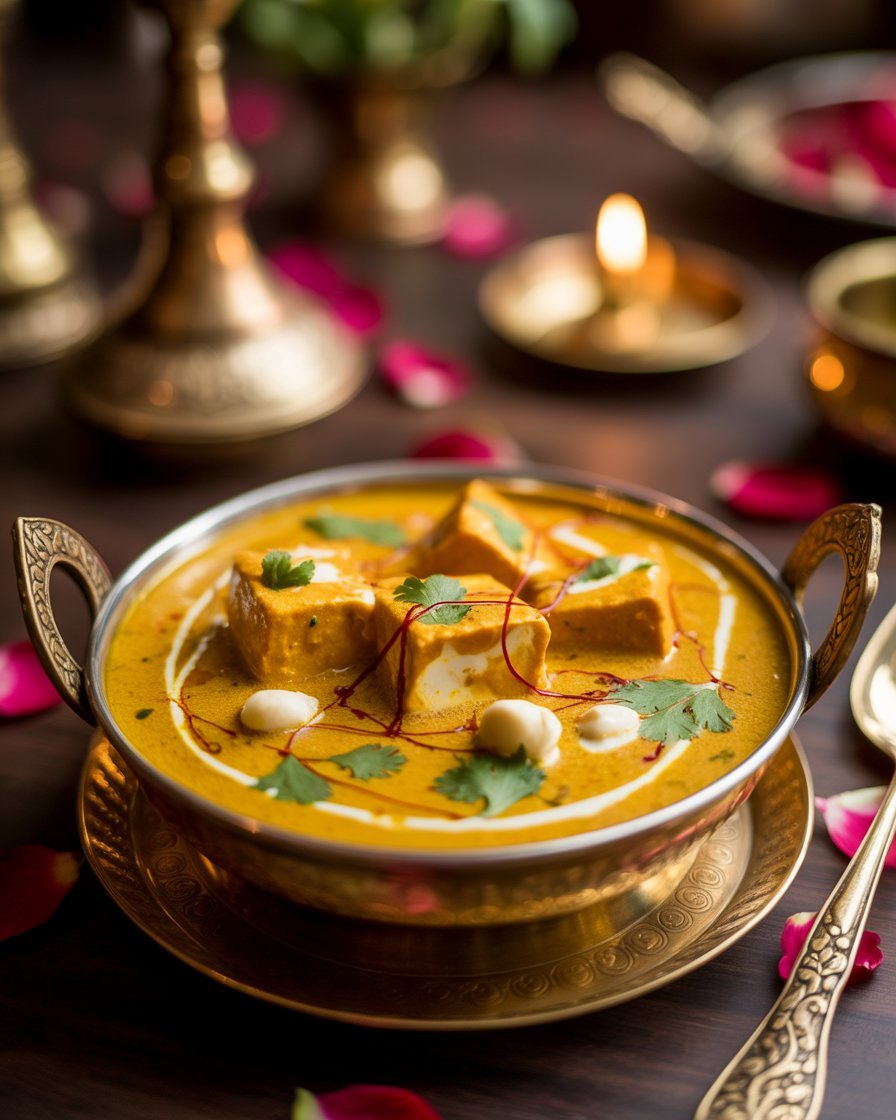Shahi Paneer is a quintessential Mughlai dish that epitomizes the richness and grandeur of Indian royal cuisine. The word “Shahi” translates to royal, and this dish lives up to its name with its luxurious blend of creamy gravy, aromatic spices, and tender paneer cubes. Originating from the Mughal era, when royal kitchens were known for their elaborate and indulgent preparations, Shahi Paneer has evolved into a beloved delicacy across India and beyond. It is a staple in Indian restaurants, especially those specializing in North Indian and Mughlai cuisine, and is often served at weddings, festive occasions, and special gatherings.
What sets Shahi Paneer apart from other paneer dishes is its opulent gravy, which is crafted using a base of onions, tomatoes, yogurt, and a medley of nuts and seeds such as cashews and almonds. The sauce is further enriched with aromatic spices like cardamom, cinnamon, cloves, and saffron, giving it a deep, complex flavor profile. The result is a thick, velvety curry that is both hearty and indulgent, making it a favorite among paneer lovers. Whether paired with warm naan, fluffy basmati rice, or jeera rice, Shahi Paneer offers a satisfying and flavorful dining experience.
Introduction to Shahi Paneer: A Royal Mughlai Delight
One of the reasons Shahi Paneer has gained widespread popularity is its versatility. While traditionally prepared with paneer, the dish can be customized to suit different tastes and dietary preferences. Some variations include adding cream for extra richness, incorporating vegetables like bell peppers and mushrooms, or adjusting the spice levels to cater to different palates. Additionally, the dish can be made healthier by using low-fat yogurt, reducing the amount of oil or ghee, and opting for whole wheat bread instead of refined flour-based naan. These adaptations make Shahi Paneer an accessible and appealing option for a wide range of diners.
Beyond its culinary appeal, Shahi Paneer also holds cultural significance. It represents the legacy of Mughal cuisine, which is characterized by its use of dairy, dried fruits, and aromatic spices. The dish reflects the influence of Persian and Central Asian culinary traditions on Indian food, making it a fascinating example of historical gastronomy. Whether enjoyed at a fine dining restaurant or recreated at home, Shahi Paneer continues to be a symbol of luxury and indulgence in Indian cuisine.
In this article, we will explore the step-by-step process of preparing an authentic Shahi Paneer recipe at home. From selecting the right ingredients to mastering the art of creating the perfect creamy gravy, this guide will provide all the necessary details to ensure a restaurant-style experience. Additionally, we will delve into the nutritional benefits of the dish, serving suggestions, and tips for achieving the best results. Whether you are a seasoned cook or a beginner in the kitchen, this Shahi Paneer recipe promises to elevate your culinary skills and impress your guests with its royal flavors.

Ingredients for Shahi Paneer: A Detailed Breakdown
To prepare an authentic and rich Shahi Paneer, it is essential to gather the right ingredients, which contribute to its distinct flavor and texture. The recipe is divided into two main components: the Shahi Paste and the sauce , each playing a crucial role in achieving the dish’s signature creaminess and depth of flavor. Below is a detailed list of all the ingredients required for both parts of the recipe, along with their measurements and purpose.
Shahi Paste Ingredients
The Shahi Paste forms the foundation of the dish, providing a rich and nutty base that enhances the overall taste of the gravy. This paste is made by blending a combination of nuts, onions, ginger, garlic, and select spices.
| Whole Cashew Nuts | 12 pieces (23 grams) | Adds a creamy texture and subtle sweetness to the gravy |
| Almonds | 10 pieces (12 grams) | Enhances richness and provides a nutty undertone |
| Green Cardamoms | 2 to 3 pods | Imparts a fragrant aroma and warmth |
| Yellow or White Onions | 1½ cups (170 grams) | Builds the base of the gravy and adds a natural sweetness |
| Fresh Ginger | 1 inch (8 grams) | Adds a pungent, spicy kick |
| Garlic Cloves | 4 large cloves (12 grams) | Provides depth and enhances the overall flavor |
| Green Chili | 1 slit (optional, deseeded if preferred) | Adds mild heat (can be omitted for a milder version) |
| Water | ⅓ cup (80 ml) | Used for blending the ingredients into a smooth paste |
Sauce Ingredients
Once the Shahi Paste is ready, the sauce is prepared using a combination of aromatic spices, dairy, and additional flavorings that elevate the dish to a royal level.
| Paneer | 225 to 250 grams | The main ingredient, cut into cubes and simmered in the gravy |
| Ghee or Oil | 3 tablespoons (divided into 1 + 2 tablespoons) | Used for frying the nuts and sautéing the spices |
| Bay Leaf | 1 piece | Adds an earthy and aromatic note |
| Shahi Jeera (Indian Caraway Seeds) | ½ teaspoon (optional, can substitute with cumin seeds) | Provides a distinct, nutty flavor |
| Cinnamon Stick | 2-inch piece (optional) | Adds warmth and depth to the sauce |
| Cloves | 2 pieces | Contribute a rich, spicy aroma |
| Kashmiri Red Chili Powder | ¼ to ½ teaspoon (optional) | Imparts a mild heat and vibrant red color |
| Turmeric Powder | ¼ teaspoon (optional) | Adds a yellow hue and earthy flavor |
| Salt | ½ teaspoon (adjust to taste) | Balances the flavors |
| Garam Masala | ¾ to 1 teaspoon (adjust to taste) | Enhances the overall aroma and warmth |
| Plain Yogurt (Indian Curd) | ½ cup (130 grams) | Thickens the gravy and adds a tangy flavor |
| Water | ¾ to 1 cup (adjust as needed) | Used to adjust the consistency of the sauce |
| Black Pepper | ⅛ to ¼ teaspoon (adjust to taste) | Adds a subtle spiciness |
| Saffron Strands | 1 pinch (optional) | Provides a luxurious aroma and golden hue |
| Kewra Water or Rose Water | 2 to 4 drops (optional) | Enhances fragrance and adds a floral note |
| Heavy Cream | 3 tablespoons (whipping cream, optional) | Adds richness and a velvety texture |
These ingredients work together to create a well-balanced and indulgent Shahi Paneer that captures the essence of Mughlai cuisine. With the right selection and combination of spices, nuts, and dairy, this dish delivers an unforgettable culinary experience.
Step-by-Step Instructions for Preparing Shahi Paneer
Creating an authentic Shahi Paneer at home is a rewarding culinary experience that yields a rich, creamy, and flavorful dish. This step-by-step guide will walk you through the process of preparing the Shahi Paste and assembling the final dish, ensuring a restaurant-style result.
Step 1: Prepare the Shahi Paste
The Shahi Paste serves as the foundation of the dish, providing a nutty and aromatic base that enhances the overall flavor. Follow these steps to create a smooth and rich paste:
- Fry the Nuts and Spices:
- In a pan, heat 1 tablespoon of ghee or oil over medium heat.
- Add 12 whole cashew nuts, 10 almonds (or almond flour), and 2 to 3 green cardamoms .
- Sauté for 2 to 3 minutes , stirring constantly until the nuts turn slightly golden. This step releases their natural oils and enhances their flavor.
- Add Aromatics:
- Add 1½ cups of diced onions (about 2 medium onions) to the pan.
- Toss in 1 inch of sliced ginger and 4 garlic cloves (roughly chopped) .
- If using, add 1 slit green chili for a mild heat.
- Sauté the Mixture:
- Cook the mixture on medium heat for 5 to 6 minutes , stirring occasionally.
- As the onions begin to soften, add 3 to 4 tablespoons of water to deglaze the pan and prevent burning.
- Continue cooking for another 3 to 4 minutes until the onions turn translucent and the raw smell of the spices dissipates.
- Cool and Blend:
- Remove the pan from heat and allow the mixture to cool for a few minutes.
- If using a green chili and prefer a milder version, remove it before blending.
- Transfer the mixture to a blender or food processor.
- Add ⅓ cup of water and blend into a smooth, fine paste. The consistency should be thick yet spreadable. Set aside for the next step.
Step 2: Assemble the Shahi Paneer Sauce
Once the Shahi Paste is ready, it’s time to build the sauce, infusing it with aromatic spices and dairy for a rich and creamy texture.
- Temper the Whole Spices:
- In a separate pan, heat the remaining 2 tablespoons of ghee or oil over medium heat.
- Add 1 bay leaf, ½ teaspoon of shahi jeera (or cumin seeds), a 2-inch cinnamon stick, and 2 cloves .
- Let the spices sizzle for 30 seconds , releasing their fragrance.
- Add the Shahi Paste:
- Pour in the prepared Shahi Paste and stir well to combine.
- Add ¼ to ½ teaspoon of Kashmiri red chili powder (optional), ¼ teaspoon turmeric (optional), ½ teaspoon salt, and ¾ to 1 teaspoon of garam masala .
- Mix thoroughly and cook for 3 to 4 minutes , allowing the flavors to meld together.
- Incorporate Yogurt:
- In a separate bowl, whisk ½ cup of plain yogurt to ensure a smooth consistency.
- To prevent curdling, add 1 to 2 tablespoons of the hot sauce mixture to the yogurt and mix well.
- Gradually add the yogurt mixture back into the pan in two batches , stirring continuously to avoid separation.
- Cook for another 2 to 3 minutes on medium heat, allowing the yogurt to integrate smoothly into the sauce.
then Shahi Paneer Sauce
- Simmer the Sauce:
- Pour in ¾ to 1 cup of water , depending on how thick or thin you prefer the gravy.
- Stir well and bring the mixture to a gentle simmer.
- Cook for 10 minutes or until the sauce thickens and the oil starts to separate, forming a creamy and rich texture.
- Add Paneer and Final Touches:
- Gently add 225 to 250 grams of paneer cubes to the sauce.
- Sprinkle in ⅛ to ¼ teaspoon of black pepper for a subtle heat.
- For added richness, stir in 3 tablespoons of heavy cream (optional).
- Let the paneer cook for 1 to 2 minutes , allowing it to absorb the flavors.
- Optionally, crush a small pinch of saffron strands and sprinkle them over the dish.
- Add 2 to 4 drops of kewra water or 1 teaspoon of rose water for a floral aroma (optional).
- Rest and Serve:
- Cover the pan and let the Shahi Paneer rest for 5 to 7 minutes , allowing the flavors to develop fully.
- Serve hot with naan, roti, jeera rice, or plain basmati rice for a complete and indulgent meal.
By following these detailed steps, you can recreate an authentic and flavorful Shahi Paneer that rivals restaurant-quality dishes. With the right balance of spices, nuts, and dairy, this Mughlai classic delivers a luxurious and satisfying experience.

Nutritional Benefits of Shahi Paneer
Shahi Paneer is not only a rich and indulgent dish but also a nutritious meal that provides a good balance of macronutrients and essential vitamins. This creamy paneer curry is packed with protein, healthy fats, and essential minerals, making it a well-rounded option for those seeking a hearty and satisfying meal. Below is a breakdown of the nutritional content per serving, based on the standard recipe.
Nutrition Facts (Per Serving)
| Calories | 365 kcal | – |
| Total Fat | 31g | 48% |
| Saturated Fat | 17g | 106% |
| Polyunsaturated Fat | 1g | – |
| Monounsaturated Fat | 6g | – |
| Cholesterol | 71mg | 24% |
| Sodium | 368mg | 16% |
| Potassium | 209mg | 6% |
| Carbohydrates | 13g | 4% |
| Fiber | 3g | 13% |
| Sugar | 4g | 4% |
| Protein | 12g | 24% |
| Vitamin A | 75 IU | 2% |
| Vitamin C | 6mg | 7% |
| Calcium | 347mg | 35% |
| Iron | 1mg | 6% |
Key Nutritional Benefits
- High in Protein : Paneer is an excellent source of high-quality protein, making this dish particularly beneficial for muscle repair, growth, and overall body function. The protein content also helps keep you full for longer, making it a satisfying meal option.
- Rich in Calcium : With 347mg of calcium per serving , Shahi Paneer supports bone health and helps maintain strong teeth and muscles. This makes it an ideal dish for individuals looking to increase their calcium intake without relying solely on dairy products.
- Healthy Fats : The inclusion of nuts like cashews and almonds contributes to the dish’s healthy fat content , particularly monounsaturated fats. These fats are known to support heart health, reduce inflammation, and improve cholesterol levels.
- Essential Vitamins and Minerals : The combination of spices, vegetables, and dairy ensures a diverse range of nutrients. For instance, ginger and garlic provide antioxidants, while onions and tomatoes contribute to vitamin C and potassium intake.
- Balanced Macronutrients : With a mix of carbohydrates from the onions and spices, protein from the paneer, and fats from ghee and nuts, Shahi Paneer offers a well-rounded nutritional profile.
While this dish is rich in flavor and nutrition, it is also relatively high in saturated fat due to the use of ghee and cream. For those looking to make it healthier, modifications such as using low-fat yogurt, reducing oil usage, or omitting heavy cream can help balance the nutritional content while still preserving the dish’s luxurious taste.
Serving Suggestions for Shahi Paneer
Shahi Paneer is a versatile dish that pairs beautifully with a variety of accompaniments, making it suitable for any meal of the day—be it breakfast, lunch, or dinner. Its rich, creamy gravy complements a range of Indian breads and rice preparations, allowing you to customize your meal based on preference and occasion.
Best Accompaniments for Shahi Paneer
- Naan and Roti
The most traditional way to enjoy Shahi Paneer is with freshly made naan or roti . The soft, pillowy texture of naan makes it perfect for soaking up the thick, flavorful gravy. For a more indulgent experience, try butter naan or garlic naan , which enhance the richness of the dish. If you’re looking for a healthier option, whole wheat roti or multigrain paratha pairs well while adding a wholesome touch to the meal. - Basmati Rice
Shahi Paneer is equally delightful when served over a bed of fragrant basmati rice . The lightness of the rice balances the heaviness of the curry, making it a satisfying and well-rounded meal. For an elevated touch, opt for saffron rice, turmeric rice, or jeera rice , which add extra layers of flavor and color. - Pulao and Biryani
If you’re looking for a more elaborate meal, serve Shahi Paneer alongside vegetable pulao or paneer biryani . The aromatic spices in the rice complement the creamy paneer curry, making it a perfect combination for festive meals or special gatherings. - Tandoori Appetizers
For a complete North Indian spread, pair Shahi Paneer with tandoori starters such as paneer tikka, tandoori chicken, or stuffed kebabs . This combination creates a rich and hearty meal, ideal for dinner parties or celebratory occasions.
Presentation Tips for an Elegant Meal
To enhance the visual appeal of Shahi Paneer, consider garnishing the dish with a dollop of fresh cream or a swirl of melted butter before serving. A sprinkle of chopped coriander leaves or toasted slivered almonds adds a pop of color and texture. For an aromatic finish, a few drops of rose water or kewra water can be added just before serving, infusing the dish with a subtle floral note.
Whether you’re enjoying a quiet dinner at home or hosting a special occasion, Shahi Paneer’s rich flavors and luxurious texture make it a standout dish that pairs effortlessly with a variety of accompaniments.
Tips and Tricks for Perfecting Shahi Paneer
Making Shahi Paneer at home can be a rewarding experience, but a few key tips and tricks can help you achieve the perfect balance of flavors and textures. Whether you’re a beginner or an experienced cook, these insights will ensure your Shahi Paneer turns out rich, creamy, and restaurant-style every time.
1. Use Fresh, High-Quality Ingredients
The richness of Shahi Paneer comes from its ingredients, so it’s essential to use fresh and high-quality components. Opt for fresh paneer that is soft and moist, as dry or stale paneer can become rubbery when cooked. Similarly, use good-quality ghee or oil for frying the nuts and tempering the spices, as this enhances the depth of flavor. If you’re using dairy products like yogurt and cream , make sure they are fresh to avoid any sour notes in the gravy.
2. Soak Nuts for a Smoother Paste
If you don’t have a high-powered blender, soaking the cashews and almonds in hot water for 30 minutes before blending can help achieve a smoother paste. This step softens the nuts, making them easier to grind into a fine, creamy texture without leaving any gritty bits in the sauce. Alternatively, you can use almond flour or blanched almonds for convenience.
3. Avoid Curdling the Yogurt
One common issue when making Shahi Paneer is the risk of curdling the yogurt, which can make the gravy look unappetizing. To prevent this, always temper the yogurt before adding it to the hot sauce. Start by whisking the yogurt in a separate bowl, then gradually add 1 to 2 tablespoons of the hot sauce mixture to it while stirring continuously. This gradual temperature adjustment helps prevent the yogurt from curdling when incorporated into the main dish.
4. Adjust the Spice Levels to Taste
While Shahi Paneer is known for its aromatic and mildly spiced flavor, you can easily adjust the heat level according to your preference. If you prefer a milder version, reduce or omit the Kashmiri red chili powder and skip the black pepper . For those who enjoy a bit more heat, you can add green chilies or crushed red chili flakes . Additionally, if you want to enhance the warmth of the dish, increase the garam masala slightly for a deeper, more complex flavor.
5. Substitute Ingredients for Dietary Preferences
Shahi Paneer can be modified to accommodate different dietary needs without compromising on taste. For a healthier version , use low-fat yogurt and reduce the amount of ghee . If you’re looking for a vegan alternative , substitute paneer with firm tofu and use plant-based yogurt and cream . You can also experiment with different types of nuts , such as macadamia or pistachios , for a unique twist on the traditional recipe.
6. Let the Dish Rest Before Serving
Allowing the Shahi Paneer to rest for 5 to 7 minutes after cooking helps the flavors meld together and enhances the overall richness of the dish. Cover the pan and let it sit before serving to ensure the best possible taste and texture.
By following these tips, you can master the art of making Shahi Paneer at home and enjoy a luxurious, restaurant-quality dish with ease.

Frequently Asked Questions (FAQs) About Shahi Paneer
Shahi Paneer is a beloved dish that many home cooks enjoy preparing, but it’s natural to have questions about the best ways to make it, store it, and adapt it to personal preferences. Below are some of the most commonly asked questions about Shahi Paneer, along with detailed answers to help you perfect your recipe.
1. Can Shahi Paneer Be Made Ahead of Time?
Yes, Shahi Paneer can be prepared in advance and stored for later consumption. The rich, creamy sauce actually tends to develop deeper flavors when left to rest. To store, allow the dish to cool completely, then transfer it to an airtight container and refrigerate for up to 3 to 4 days . When reheating, gently warm it on the stovetop over low heat, adding a splash of water or milk if the sauce has thickened too much.
2. How Can I Make Shahi Paneer Healthier?
While Shahi Paneer is naturally rich due to the use of ghee, cream, and nuts, there are several ways to make it healthier without sacrificing flavor:
- Use Low-Fat Yogurt: Replace full-fat yogurt with low-fat or Greek yogurt to reduce the overall fat content.
- Reduce Ghee Usage: Instead of frying the nuts and sautéing the onions in ghee, use a minimal amount of oil or opt for a heart-healthy oil like olive or avocado oil.
- Skip Heavy Cream: Omit the heavy cream or substitute it with a small amount of coconut cream for a lighter yet still creamy texture.
- Use Whole Wheat Bread: Pair the dish with whole wheat naan or roti instead of white flour varieties for added fiber and nutrients.
3. Can I Freeze Shahi Paneer?
Yes, Shahi Paneer can be frozen for longer storage, though the texture of the paneer may change slightly upon thawing. To freeze, place the cooled dish in a freezer-safe container or ziplock bag and store it for up to 2 to 3 months . When ready to eat, thaw it in the refrigerator overnight and reheat gently on the stovetop. Keep in mind that the paneer may become slightly firmer after freezing, but the overall flavor remains intact.
4. What Are Some Good Substitutes for Paneer?
If you’re looking for alternatives to paneer, especially for a vegan or lactose-free version, consider the following options:
- Tofu: Firm tofu is an excellent substitute for paneer, as it holds its shape and absorbs flavors well.
- Halloumi: This cheese has a firm texture and a mild salty flavor, making it a good alternative.
- Tempeh or Seitan: These plant-based proteins can be used in place of paneer for a vegan version, though they will alter the taste slightly.
5. Is It Possible to Make Shahi Paneer Without a Blender?
While a blender is typically used to make the Shahi paste, it is possible to prepare the dish without one. Instead of blending the nuts, onions, ginger, and garlic into a smooth paste, you can finely chop or grate them and cook them directly in the pan. This method will result in a slightly coarser texture, but the flavors will still meld together nicely during cooking.
6. What Should I Do If My Shahi Paneer Turns Too Thick or Too Thin?
- Too Thick: If the gravy is too thick, simply add a small amount of water, milk, or even coconut milk to thin it out to your desired consistency.
- Too Thin: If the sauce is too runny, continue simmering it on medium heat until it reduces and thickens naturally. You can also mix a small amount of cornstarch with water and add it to the sauce to help it thicken.
By addressing these common questions, you can confidently prepare and customize Shahi Paneer to suit your preferences and dietary needs while ensuring a delicious and satisfying meal every time.

